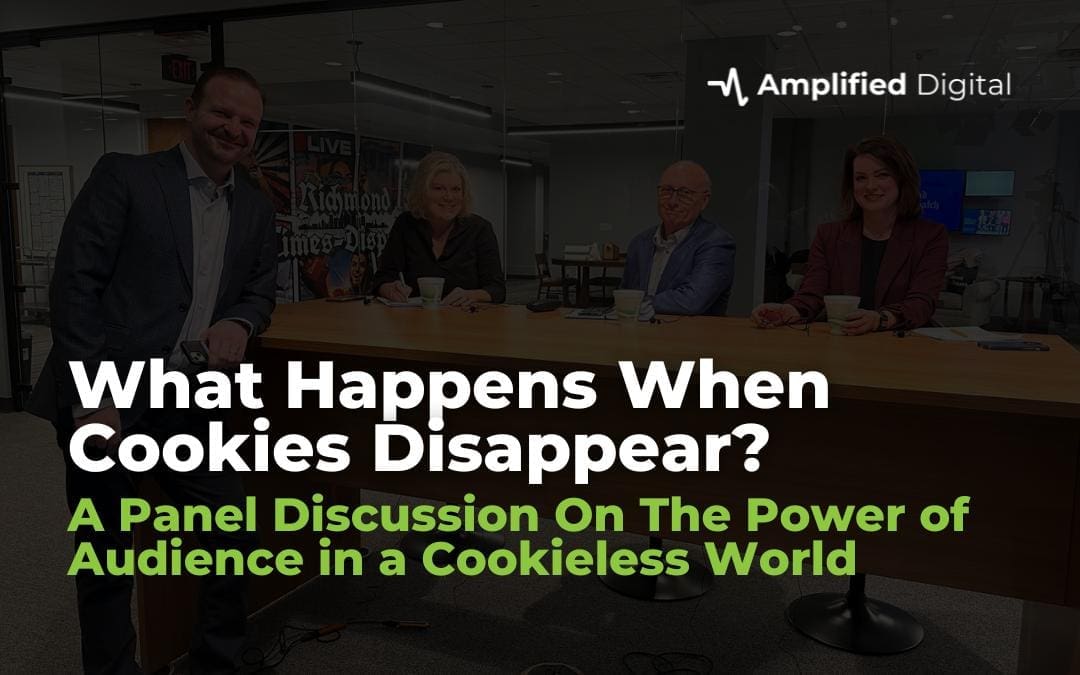As the digital advertising landscape braces for a significant shift, experts gathered at a panel hosted by the Richmond Times Dispatch to discuss the future of marketing in a cookie-less world. The session, led by moderator Joe Battistoni, featured insights from industry leaders including Jolene Sherman, Gordon Borrell, and Kelly Till, shedding light on the urgency of transitioning from reliance on third-party cookies to embracing new strategies for audience engagement.
This article captures the essence of their discussion, showcasing valuable perspectives for advertisers navigating the impending changes.
Check out the Full Panel Discussion
The Urgency of Transitioning From Third-Party Cookies
In the ever-evolving landscape of digital advertising, the impending shift away from third-party cookies marks a pivotal moment for marketers and advertisers. This transition is fueled by growing privacy concerns and regulatory changes, signaling a critical need for the industry to adapt.
While the change is eminent, it’s not all doom and gloom. As highlighted during the expert panel discussion Jolene Sherman, President and Managing Director of Amplified Digital Agency, captures the essence of the moment, stating, “There was a marketing world before cookies, and there will be a world after cookies… it’s going to be okay.” Her reassurance underscores the inevitability of change within the digital sphere and the opportunities that lie ahead for those prepared to navigate this new terrain.
The move away from third-party cookies is not merely a technical adjustment but a fundamental shift in how advertisers engage with audiences online. Privacy concerns have prompted tech giants and regulatory bodies to rethink the mechanisms of digital tracking and targeting, leading to the gradual phasing out of third-party cookies. This development presents a unique set of challenges and opportunities for marketers accustomed to the granular targeting capabilities afforded by third-party data.
The transition demands a reevaluation of strategies, urging advertisers to explore alternative methods that respect user privacy while still delivering personalized advertising experiences.
Understanding the implications of this transition is crucial for advertisers aiming to stay ahead in a competitive market. The disappearance of third-party cookies will significantly impact retargeting practices, a staple in digital advertising strategies known for its effectiveness in engaging potential customers based on their previous online activities.
Gordon Borrell talked about retargeting during the panel stating “It’s a very useful form of advertising. I searched for a pressure washer for my son-in-law and, God knows, everywhere I go, whatever site I go on, I’m hit with ads for pressure washers. Well, it’s actually kind of useful, isn’t it? But there are more ingenious ways of targeting and, I think, much more effective ways of targeting and migrating the first party data.”
The loss of this capability highlights the need for innovative approaches to audience engagement and data collection. As the landscape evolves, the reliance on third-party cookies for audience targeting and retargeting will give way to new methodologies centered around first-party data and privacy-compliant practices.
The urgency of transitioning from third-party cookies is a call to action for the advertising industry. It represents a critical juncture at which advertisers must pivot towards more sustainable, ethical, and effective marketing practices.
Embracing this change requires a mindset shift, from viewing it as a limitation to seeing it as an opportunity to foster trust with audiences, enhance the relevance of advertising, and ultimately, drive better outcomes in a cookie-less future.
Building First-Party Data Strategies
The shift away from third-party cookies emphasizes the paramount importance of first-party data in crafting effective digital marketing strategies. In an environment increasingly governed by privacy regulations and consumer expectations for personalized experiences, first-party data emerges as the cornerstone of future advertising efforts.
Kelly Till succinctly underscores this reality: “Your own audiences, what we call your first-party data, is going to become more important than ever.”
Building a robust first-party data strategy involves direct engagement with customers and prospects to gather insights through interactions on owned channels, such as websites, social media platforms, and email newsletters. This direct relationship fosters a deeper understanding of consumer preferences, behaviors, and needs, enabling advertisers to tailor their offerings more effectively. Moreover, first-party data assures compliance with privacy standards, ensuring that consumer trust is maintained—a critical factor in the digital age.
The transition to first-party data-centric approaches necessitates a reevaluation of data collection methods. Advertisers must innovate to entice users to share their information willingly, offering value in exchange for data through personalized content, exclusive offers, and enhanced user experiences. The focus shifts from broad targeting based on third-party data to more nuanced and engaged relationships with audiences, leveraging insights drawn directly from consumer interactions.
Building first-party data strategies is not just a tactical response to the decline of third-party cookies; it’s a strategic imperative for future-proofing digital marketing efforts.
As advertisers navigate this new landscape, the emphasis on first-party data not only aligns with the evolving regulatory and consumer landscape but also opens up new avenues for creative engagement and customer loyalty.
The journey towards mastering first-party data is both a challenge and an opportunity to redefine the foundations of digital advertising in a privacy-first world.
The Role of Verified Human Audiences
The impending obsolescence of third-party cookies heralds a pivotal shift towards valuing verified human audiences in the digital marketing realm. Jolene, emphasizing this transition, states, “What we also know is that as CMOs and marketers and business owners, your own audiences—what we call your first-party data—is going to become more important than ever. You’re going to need to learn how to capture it, harness it, and leverage it.”
This insight underscores the importance of engaging with actual individuals rather than relying on impersonal, aggregated data. Verified human audiences not only enhance the precision and relevance of advertising campaigns but also build a foundation of trust and integrity in digital marketing efforts.
Sherman’s perspective highlights a critical strategy shift for advertisers: focusing on the quality of audience engagement over quantity. By prioritizing interactions with verified individuals, advertisers can ensure their messaging resonates with genuinely interested parties, thereby improving both campaign efficiency and effectiveness.
This approach demands a more nuanced understanding of audience behavior and preferences, facilitated by robust first-party data collection and analysis. In this new era of digital advertising, verified human audiences stand at the forefront, guiding advertisers towards more authentic, impactful, and ethically grounded marketing practices.
Adapting Strategies for Local and Contextual Targeting
As the digital advertising landscape evolves away from reliance on third-party cookies, advertisers are increasingly turning towards local and contextual targeting strategies to reach their audiences more effectively. This shift highlights the significant value of newspaper websites as powerful platforms for advertising. Newspaper websites, with their rich, locally relevant content and engaged readership, offer an unparalleled opportunity for advertisers to connect with verified human audiences in a meaningful way.
Kelly underscores this point by emphasizing the advantages of local publishers as walled gardens offering targeted advertising capabilities. She points out, “Newspaper websites have loyal and local readership. So the importance of that is it means that ads are seen by real people, not bots, and it’s in a privacy compliant, ethical, and trusted environment.”
This insight brings to light the unique position of newspaper websites as not just media outlets but as trusted community pillars. By leveraging the local and contextual relevance of content on these sites, advertisers can ensure their messages are not only seen but also resonate with their intended audience.
Adapting advertising strategies to include local and contextual targeting on newspaper websites allows advertisers to benefit from the direct, trusted relationship these publications have with their readers. It enables a level of precision and relevance that goes beyond the capabilities of broad, cookie-based targeting, aligning ads with content that readers are actively engaged with.
This not only enhances the effectiveness of the ads but also contributes to a positive user experience, fostering a sense of community and relevance. In a cookie-less future, the strategic use of local and contextual targeting on newspaper websites emerges as a key avenue for advertisers seeking to connect with their audiences in a more meaningful and impactful way.
The Rise of Email Marketing
In the wake of the digital advertising industry’s pivot away from third-party cookies, the rise of email marketing emerges as a pivotal strategy for businesses seeking to maintain and enhance direct engagement with their audiences.
This resurgence underscores the enduring value of email as a channel for personalized, consent-based communication. As Jolene eloquently puts it, “Email addresses are going to be king in this new world as we use them as a unique identifier.” This points to the integral role of email in the future of digital marketing, but also marks a return to strategies that prioritize direct and meaningful engagement with consumers.
Email marketing’s ascent is predicated on its ability to offer highly targeted communication that respects user privacy and preferences. Unlike the passive nature of cookie-based targeting, email allows businesses to engage with individuals who have explicitly shown interest in their brand, products, or services by opting into communication.
This level of engagement ensures that marketing messages are not only more relevant but also more welcome, leading to higher engagement rates and deeper customer relationships. Furthermore, email marketing’s versatility in content delivery—from newsletters and promotional offers to personalized recommendations—makes it an invaluable tool for building brand loyalty and driving conversions.
In a digital landscape increasingly focused on privacy and user consent, email marketing stands out as a strategy that aligns with these values while offering businesses the agility to adapt to changing consumer behaviors. Its rise signifies a shift towards more sustainable and ethical marketing practices, where the value exchange between businesses and their customers is clear and mutually beneficial. As advertisers navigate the post-cookie world, the strategic incorporation of email marketing into their overall digital strategy will not only be a necessity but a competitive advantage.
Future Predictions and Adaptations
As the digital advertising world braces for a significant paradigm shift with the phase-out of third-party cookies, industry experts are not just looking at the immediate impacts but also forecasting the long-term adaptations necessary for success.
Jolene offers a profound prediction that encapsulates the essence of this transition: “I definitely predict that we need to treat first-party data as priority, and you as a CMO or marketer need to take that first-party data and make sure that you have a really cohesive and coherent strategy on how to leverage it. If you’re not doing that today, I predict it’s going to become the most important thing you think about in your future in terms of your marketing dollars and your expense.”
The adaptation to a cookie-less world will require marketers to rethink their strategies fundamentally. It calls for a balance between technological innovation and a return to marketing fundamentals—understanding your audience, engaging them with relevant content, and building loyalty over time.
This transition presents an opportunity for brands to differentiate themselves by how well they understand and cater to their customers’ needs and preferences. As businesses navigate these changes, the predictions and insights from experts like Sherman offer a roadmap for thriving in a future where first-party data and direct customer relationships are paramount.
The journey ahead will be challenging, but it also promises a more transparent, respectful, and customer-centric approach to digital advertising.
Contact Amplified Digital Agency to Help Navigate the Cookieless World
Leverage the power of verified human audiences with Amplified Digital Agency, backed by the extensive network of Lee Enterprises’ newspaper websites.
Our partnership provides unparalleled access to local and engaged audiences across trusted platforms, enhancing your advertising strategy in a cookieless world.
For tailored solutions that connect you with real, interested customers through contextual and local targeting, reach out to Amplified Digital Agency.
Discover how we can elevate your advertising approach at Amplified Digital Agency.
Behind the Scenes of the Cookieless World Panel





